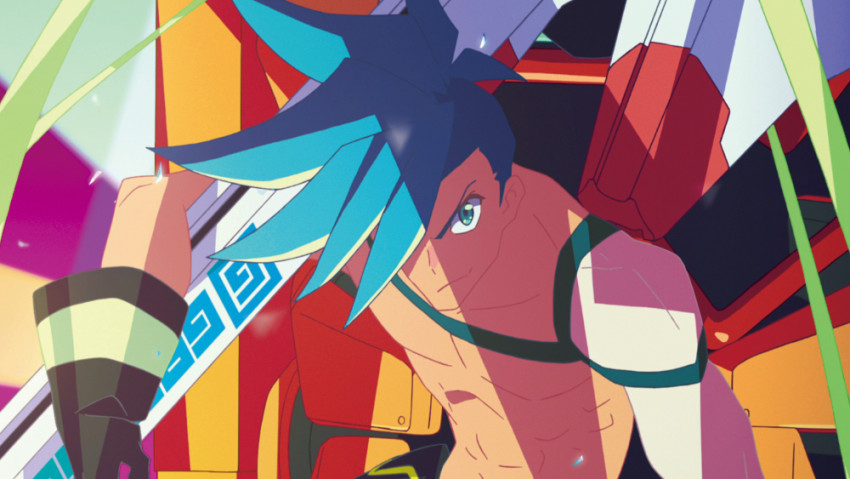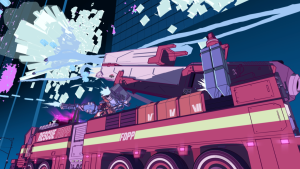Promare
September 27, 2019 · 0 comments
By Shelley Pallis.
 Thirty years ago, a cataclysm destroyed half the world. A new race was born from the flames: the Burnish, fire-starting mutants who present a danger to society. Set against them to keep modern society safe is the Burning Rescue fire squad. Galo Thymos (Kenichi Matsuyama) is their newest raw recruit, a hot-headed hero with blue spiky hair, whose first mission drags him into a one-to-one conflict with the leader of the “Mad” Burnish, Lio Fotia (Taichi Saotome).
Thirty years ago, a cataclysm destroyed half the world. A new race was born from the flames: the Burnish, fire-starting mutants who present a danger to society. Set against them to keep modern society safe is the Burning Rescue fire squad. Galo Thymos (Kenichi Matsuyama) is their newest raw recruit, a hot-headed hero with blue spiky hair, whose first mission drags him into a one-to-one conflict with the leader of the “Mad” Burnish, Lio Fotia (Taichi Saotome).
The first animated feature from the fan-favourite studio Trigger (assisted by XFLAG and Sanzigen), early trailers for Promare led to an unkind critical response of “Gurren La Kill.” It did, after all reunite the director, Hiroyuki Imaishi, writer Kazuki Nakashima, and designer Shigeto Koyama from the earlier shows Gurren Lagann and Kill la Kill, and its artwork plainly established it as a work in the same mould. Long-time Imaishi fans will immediately see echoes of his earlier productions – the hyper-kinetic action and garish pastels of Dead Leaves, for example, and the hard-edged geometries of Panty and Stocking with Garterbelt. But this is the first work that Imaishi has had full control over since Gurren Lagann, and here he luxuriates in the freedom to do whatever he wants, repeatedly, in an unrelenting series of eyeball kicks, extreme zooms, false colours, vertiginous perspectives and screaming guitars.
“Since TV anime always consists of a series of ‘thirty-minute’ episodes, it was quite difficult for me to get the balance right for a two-hour movie,” confessed Imaishi to NHK’s Imagine-Nation programme. “With TV anime, I was used to designing a story structure that took place within twenty minutes, so for a film I have to think very hard about it. In depicting the battle between Galo and Lio, I think the main theme of the anime is the rivalry that exists is that between the one who starts the fire, and the one who extinguishes the fire. The anime’s drama revolves around these two completely opposite characters, and their unique relationship.”
 It also draws on some native traditions in fire-fighting, unique to Japan. “Firemen” in the samurai era were not quite what most foreigners might imagine. Originally, they were contending guilds of heavy-set bruisers, who could be commissioned in advance to show up at your burning house and ransack it. Water was thrown on not to save the house, but to protect the looters as they carried out as much of your stuff for you as they could. Sometimes, rival guilds would show up to a fire, and get involved in punch-ups over who had the right to be there. Shop-owners took to hanging the banners of specific guilds over their front doors so that everybody knew where their affiliations were – the origins of today’s noren half-curtains, still found on many a Japanese restaurant, but today for show only. The fire guilds would brandish staff-like matoi banners of their own, the origin of the “matoi-tech” powered-suit devices employed onscreen in Promare.
It also draws on some native traditions in fire-fighting, unique to Japan. “Firemen” in the samurai era were not quite what most foreigners might imagine. Originally, they were contending guilds of heavy-set bruisers, who could be commissioned in advance to show up at your burning house and ransack it. Water was thrown on not to save the house, but to protect the looters as they carried out as much of your stuff for you as they could. Sometimes, rival guilds would show up to a fire, and get involved in punch-ups over who had the right to be there. Shop-owners took to hanging the banners of specific guilds over their front doors so that everybody knew where their affiliations were – the origins of today’s noren half-curtains, still found on many a Japanese restaurant, but today for show only. The fire guilds would brandish staff-like matoi banners of their own, the origin of the “matoi-tech” powered-suit devices employed onscreen in Promare.
Passion is the watchword here: the effulgent, burning ardour that is a staple of every anime show for young boys, a bombastic, testosterone-blinded spirit that can overcome all odds just be believing it is possible. In this case, Galo saves the world not only by doing it, but by believing it can be done in the first place, when many other would-be heroes have just given up. “Burning” is an anime script-writer’s short-hand for youthful exuberance and fannish enthusiasm, a visceral excitement and a gung-ho mentality as super-heroes bellow out the name of their next super-attack move. But Promare is a film for grown-ups, riffing on such childhood entertainments, and investing them with sardonic humour.
Imaishi’s world is permanently cranked up to eleven, in the disasters it faces and the interactions of its characters. Galo can’t even look at a building without a camera rocketing up close to his face from three miles away – one looks forward to anime fans trying to be Galo For the Day, resituating his EXTREME EXCITEMENT to everyday situations like ordering in McDonalds or buying a cinema ticket at the Edinburgh Filmhouse.
Buried somewhere beneath all the shouting and heroism in Promare is a deeper subplot about a surveillance society. Fear of the Burnish – an extreme form of illegal immigration – has given the government the chance to restrict many democratic freedoms in the hunt against a new form of terror. “Thirty years ago”, give or take, puts our real-world allegory back to the time of the first Gulf War, when a military-isolationist Japan was confronted with the potential blowback from distant battles and a globalised economy. That path led, in anime form, to the overseas traumas of Patlabor 2, the military search for a McGuffin in Howl’s Moving Castle, and the home-grown battles of Summer Wars. In Promare, the same influences are reimagined as a brightly-coloured, absurdist outbreak of forbidden colours and dangerous emotions, suppressed with extreme prejudice by a bunch of yelling nutjobs in robot suits with magic hoses.
As Matt Schey wrote in the Japan Times; “Just try to leave the theatre without feeling a blazing passion in your guts.”
Promare is released on Blu-ray and DVD by Anime Ltd.
Leave a Reply